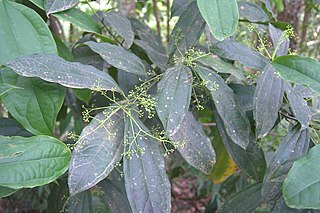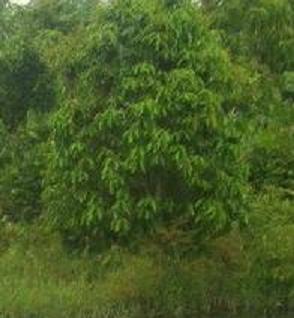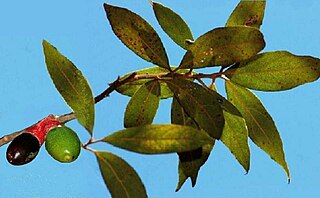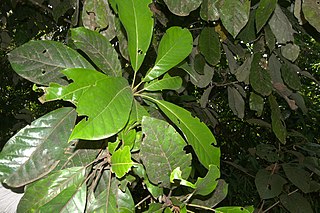
The flowering plant family Lauraceae, the laurels, includes the true laurel and its closest relatives. This family comprises about 2850 known species in about 45 genera worldwide. They are dicotyledons, and occur mainly in warm temperate and tropical regions, especially Southeast Asia and South America. Many are aromatic evergreen trees or shrubs, but some, such as Sassafras, are deciduous, or include both deciduous and evergreen trees and shrubs, especially in tropical and temperate climates. The genus Cassytha is unique in the Lauraceae in that its members are parasitic vines.

Persea is a genus of about 150 species of evergreen trees belonging to the laurel family, Lauraceae. The best-known member of the genus is the avocado, P. americana, widely cultivated in subtropical regions for its large, edible fruit.

Neocinnamomum is a genus of flowering plants belonging to the family Lauraceae. They are evergreen shrubs or small trees, indigenous to Bhutan, China, India, Indonesia (Sumatra), Myanmar, Nepal, Thailand, and Vietnam.

Aiouea is a genus of shrubs and trees in the family Lauraceae. It is native to tropical forests and montane forests of North and South America.

Aniba is an American neotropical flowering plant genus in the family Lauraceae. They are present in low and mountain cloud forest in Caribbean islands, Central America, and northern to central South America.

Beilschmiedia is a genus of trees and shrubs in family Lauraceae. Most of its species grow in tropical climates, but a few of them are native to temperate regions, and they are widespread in tropical Asia, Africa, Madagascar, Australia, New Zealand, North America, Central America, the Caribbean, and South America. The best-known species to gardeners in temperate areas are B. berteroana and B. miersii because of their frost tolerance. Seeds of B. bancroftii were used as a source of food by Australian Aborigines. Timbers of some species are very valuable.

Caryodaphnopsis is a genus of 16 species belonging to the flowering plant family Lauraceae, distributed in tropical areas in southern North America, northern South America, and East and Southeast Asia.

Mezilaurus is a genus of plant in the family Lauraceae. It is a neotropical genus consisting of 18-27 species, mostly hardwood evergreen trees, occurring from Costa Rica to the southeast of Brazil. 13 species have been identified in Brazil, distributed mostly in the Amazon region. In Rio de Janeiro state only M. navalium (Allemão) Taub. ex Mez has been recorded. Some species have been reported within the Cerrado and in semideciduous forest surrounding the Pantanal Matogrossense. The name Mezilaurus refers to its similar appearance to the genus Laurus.

Ravensara is a genus of trees and shrubs of the family Lauraceae and endemic to the island of Madagascar and the Comoro Islands. The bark, leaves and fruit of the various species are rich in aromatic essential oils. In a recent generic classification of Lauraceae based on DNA sequence data by Chanderbali et al. in 2001, it was found to be part of a strongly supported clade that also includes Beilschmiedia, Potameia, Cryptocarya, Endiandra and Aspidostemon.
Gamanthera is a flowering plant genus in the family Lauraceae, with a single species endemic of Central America. These trees have a resilient wood, used as timber.
Misanteca is an American flowering plant genus in the family Lauraceae. Mostly deciduous or evergreen tall trees. These trees have a resilient wood, useful as timber, for construction and as firewood.
Aspidostemon is a genus of flowering plants belonging to the family Lauraceae. It is present from Madagascar.
Cinnadenia is a flowering plant genus belonging to the family Lauraceae. They are present in low and mountain cloud forest in Southeast Asia.

Endlicheria is a neotropical plant genus consisting of approximately 60 species, occurring mostly in northern South America and the Amazon region. Most species are medium-sized trees, sometime up to 40 metres in height, but a few species are shrubs. DNA molecular data shows that it is closely related to Rhodostemonodaphne and Ocotea.
Rhodostemonodaphne is a genus of flowering plants in the family Lauraceae. It is a neotropical genus consisting of approximately 41 species occurring in Central America and northern South America. This genus has many species that are valued for timber. The classification of the genus is unclear since the species in the genus fall into a well-supported but unresolved clade that also includes species with unisexual flowers currently placed in the genera Endlicheria and part of Ocotea.
Paraia is a genus of plant in family Lauraceae. It is a Neotropical genus with just one species, Paraia bracteata, native to the south-east of Brazil.
Potoxylon is a monotypic genus of evergreen trees belonging to the Laurel family, Lauraceae. Its only species, Potoxylon melagangai, is native to Borneo.

Williamodendron is a genus of evergreen trees belonging to the Laurel family, Lauraceae, in South America.

Sextonia is a neotropical genus of plants in the family Lauraceae, native to South America. There are two species. They grow in moist forest from 900 to 1600 m.

Neolitsea sericea is a species of tree in the family Lauraceae. It is found in China, Taiwan, south Korea, and Japan. Its natural habitat is on forest margins and slopes, and it is often found in well-progressed secondary forests.












